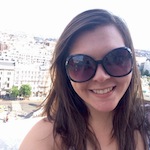 Emily Bayens is one of the students from Roanoke College, Virginia. She and her friends, also students, visited Martin a couple days ago. The leader of the group was Professor Paul R. Hilnicky from Roanoke College. Him, his lovely wife Ellen and students visited Martin, other special parts of Slovakia and infamous concentration camp in Auschwitz…
Emily Bayens is one of the students from Roanoke College, Virginia. She and her friends, also students, visited Martin a couple days ago. The leader of the group was Professor Paul R. Hilnicky from Roanoke College. Him, his lovely wife Ellen and students visited Martin, other special parts of Slovakia and infamous concentration camp in Auschwitz…
What did you like the most during your travels?
What did I like the most? That’s somewhat difficult to answer because everything was so amazing. Naturally, I’m a tourist at heart, so I enjoy any chance to fulfill my wanderlust. As far as cities go, I would say that I enjoyed Prague the best. It had such a quaint, old-world feel that Americans typically aren’t exposed to, since our nation is so young. Although the winding streets can be confusing to a newcomer, it is the perfect place to just wander around, get lost, and find something memorable. However, I did love Martin! Everyone was so kind and friendly; it was almost like we were members of the community (as much as a group of college-age, American tourists can be). Several of the other students and I often found ourselves saying that it would be the perfect place to live.
Tell us more about your experience with visiting the infamous concentration camp in Auschwitz. What did you think about, while you were there?
Originally in September or October last fall, when students first hear of their May Term options, I came across a flyer in our campus’s activity center that listed the topic of the course: Nazism, fascism, and communism. I’ve been interested in World War II and the Holocaust for about three years now, since I went on a high school trip to western Europe, where I visited sites such as Normandy, the Peace Palace in the Hague, and the annex of Anne Frank, so when I saw that the trip would be focusing on Nazism, I knew I had to look into it more. About a week or so later, at a May Term/Study Abroad Fair, I stopped by Dr. Hinlicky’s table and he told me more in detail about the trip, mentioning that we would be going to Auschwitz. I forgot about all the other May Term options and decided that I had to go to Central Europe on this trip, since it had been an item on my bucket list to visit a concentration camp (an odd thing to have on a bucket list for most people). Needless to say, I was extremely excited about Auschwitz due to my fascination with the Holocaust, World War II, and human rights.
In Auschwitz, I was overwhelmed, realizing where I was. The displays in the renovated blocks were the most impactful for me, seeing the collection of hair, suitcases, and prosthetics, which had belonged to the victims of the Holocaust was one of the hardest parts; connecting the belongings that would never be returned to their owners. Going to Birkenou was also a meaningful experience, walking in the footsteps of the one and a half million individuals who had died there is something I will never forget. It was odd, though, as it was a beautiful day. The sun was shining, the sky was a wonderful blue, and the vibrant color of the grass was almost unreal. How could nature shine so much beauty on a place where such horrible atrocities happened? It reminded me of one of my favorite quotes, which is by Ann Frank. Written during her time in the annex, when she couldn’t enjoy the sunshine or fresh air, she said, “Think of all the beauty left in the world and be happy.” The quotation reminded me that although there have been (and still are) horrible acts committed, it is important to recognize the goodness in humanity, as well as the beauty in the prospect of changing the world for the better, which combined with another quotation from Anne, “How wonderful it is that nobody need wait a single moment before starting to improve the world,” reminds me that it is our own responsibility to stand up against what is wrong to prevent anymore atrocities such as the Holocaust.
What do you like the most about Slovakia? What surprised you the most in both, positive and also in negative way?
Like I said, I really liked Martin, it was probably my favorite in Slovakia. I also really enjoyed the opportunity to receive lectures from the locals, individuals who had lived under communism. Even in America today, many details of communism are somewhat swept over, as it still doesn’t seem long ago enough to be considered history. It was fascinating for me though to see on the other side of the “Iron Curtain.” Typically, when learning about the Cold War, we get a basic description, but hearing the stories of all the lecturers’ childhoods and personal experiences added an extra, personal perspective that is necessary when learning about political religions. Something I didn’t really expect was to see the history of communism in modern Slovakia. For instance, in the first village we stayed in, Svaty Jur, Dr. Hinlicky pointed out the speakers that could be found on telephone poles, which broadcasted Soviet propaganda across the village, forcing citizens to listen.
Although there is propaganda everywhere, it is difficult for Americans to imagine being forced to listen to it. Seeing these speakers so early in the trip also made it clear that we were in fact, in a former Soviet satellite, something extremely interesting and exciting for and International Relations student to be able to say.





